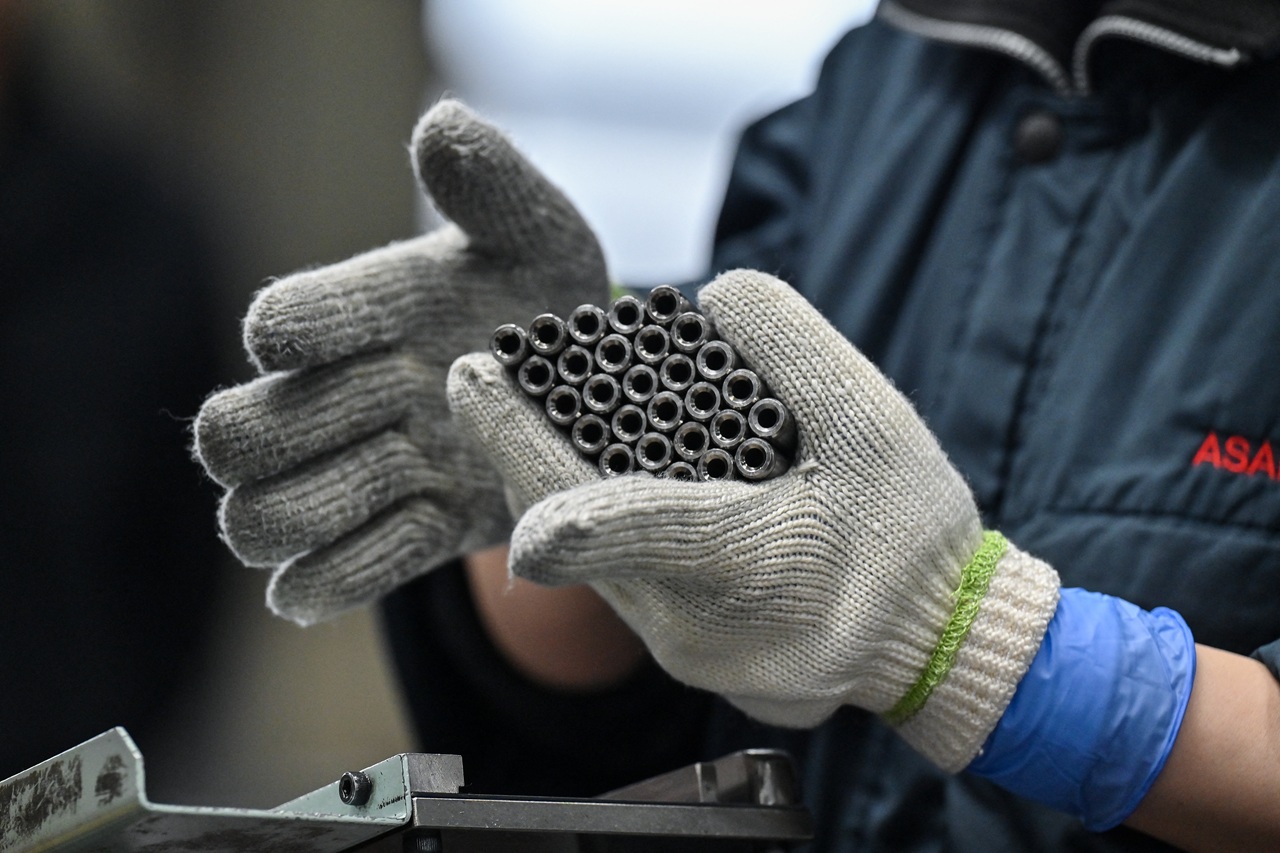
The Dreamers who are now parents
Despite years spent fighting for regularization, and having children who are U.S. citizens, many Dreamers continue to live with an uncertain future in the…
A photo shared on Facebook shows them as happy, so happy that it gives you the urge to join in with them. Eztli, 12, makes the peace sign with her fingers. Her brother Mazatl, 7, smiles while their parents, Alejandro and Alma, grin widely for the camera. Alongside the image of her family, Alma writes proudly: “My cuties.”
Alma De Jesús and Alejandro Catalán share their love, their two children, their family life — and an immigration status. Both arrived in the United States as children, brought by their families from Mexico — Alejandro from Mexico City, Alma from Guerrero — and settled down in California, where they began to live the life of any other kid their age. They each overcame the challenge of learning English and graduated from high school, which was the moment when they discovered what many other young people of their generation and situation had discovered: because they didn’t have a Social Security number, because they didn’t have documents, it would be difficult for them to keep studying.
Alma and Alejandro are part of the first generation of Dreamers.
For the past 17 years, the image that comes to mind when we talk about Dreamers is one of those young people who arrived a few years ago and are on the path to study in college and pursue options for their future. But at almost two decades after the DREAM Act was presented to Congress for the first time in August 2001, the young people who were then seeking immigration regularization have now become full-fledged adults, with their own lives constructed by struggle and effort.
And many of them, now in their thirties, are already parents.
In the United States, there are an estimated 11 million undocumented people. Of them, 3.5 million came to the country as minors. From the day that the DREAM Act was presented for the first time to now, 2 million more young people have joined the ranks of possible beneficiaries of that law, or a similar law. Remaining in limbo are those were young when the law was presented for the first time then grew up, as well as those that were already young adults with the possibility to regularize their status if the law had been passed.
In some cases, these undocumented young people have established a relationship with someone who is a legal resident or citizen of the United States, which has opened the door for them to regularize their status and have stability for them and their children. But there are some who, like Alma and Alejandro, continue living with an uncertain future despite 17 years spent fighting for regularization and having two children who are U.S. citizens.
Alma and Alejandro met in 2003 as fellow students at Santa Monica College, one of the colleges in Southern California where undocumented youth tend to begin their higher education studies thanks to the low tuition rate. Two years earlier, the DREAM Act initiative had been presented in Congress without success and it still wasn’t a relevant story for most media outlets. At the local level, some undocumented youth learned of the possible benefits that passing the law would afford them, and they began organizing in their schools. It was the era of the ICQ and AIM instant messaging platforms, as the other social networks didn’t yet exist.
It was in this early stage of the Dreamer struggle that Alma first became involved in activism.
“I think that for many of us, it was very difficult knowing that we were undocumented,” said the young woman, who is today 35 years old, with curly black hair, vivacious eyes, and an enormous smile. “Some of us discovered it when we were going to graduate high school. It was difficult to accept, but we went to college and discovered that we weren’t alone.”
Alma’s family arrived in 1990; she was six or seven at the time. She can vaguely recall the moment when she crossed the border with her older brother. Her parents and her sister were already in California, so the two were accompanied by some uncles. A steep climb, a highway, the sound of horses drawing closer — she guesses those were the immigration agents – and her uncles carrying them are all that remains of her memories of her arrival to the country. The following 28 years, practically all of her life, were lived in the United States.
More or less in the same time period, in 1989, Alejandro Catalán arrived in the country. He was seven at the time, and came by way of Tijuana: his mother, his two brothers, and he traveled in a bus to the city, where their father was waiting. That night, he showed them where to run in order to cross over.
“The border that I crossed isn’t a great wall,” recalled Alejandro, who is today 36 years old. Tall, dark-haired, with almond eyes and a discreet smile, he speaks in a paused but energetic manner. “For me it was like hopping in puddles; like it was a game, they put down wood and told us that we would cross a small river. They showed us a McDonald’s and they told us that the car would be here. When we crossed, we ran there, got in the car, and didn’t move until we reached Los Angeles.”
Just like the Catalán siblings, the De Jesús children adapted to life in the United States. They went to school, graduated from high school, and came to the point of filling out applications to go to college without having a Social Security number. Some advisors told them that the only options that were left for them were to look for work or to return to Mexico, but they also found other people that helped them forward. And so Alma and Alejandro found themselves at Santa Monica College.
The first thing that united them was their desire to fight for their right to education. They became involved in Dreamer activism through a group called ALAS, just as the movement was building its social and political base. As the years went by, the youth struggle became wider, more diverse, and in some sense more radical. Alma was one of the first activists in the movement to participate in a civil disobedience action, exposing herself to the possibility of being arrested and deported.
“In those groups, we developed a strength together; we organized, we did hunger strikes, we were filled with hope when Obama won his first election,” recalled an emotional Alma. “We signed petitions for the DREAM Act, and on the day of the vote in Congress in 2010, when it was so close to being passed, we weren’t able to even sleep. Starting at six in the morning we were waiting for the results, and afterwards, when it failed to pass, the tears. But we also knew how to overcome it.”
The young pioneers of the Dreamer struggle overcame that initial defeat so well, that they were able to transform it into the most important activist movement in recent years, forcing the media, politicians, and society as a whole to pay attention and recognize their contributions and presence in the country.
RELATED CONTENT
It’s clear to see that Eztli and Mazatl are happy children. Eztli has the calm gaze of her father and the wide smile of her mother. A family video shows her in a school talent show, dancing to the rhythm of a Bruno Mars song; the girl has talent. In a recent photo on Alma’s Instagram, Eztli, who is already a young lady, poses in front of a colored wall in between images of the Aztec goddess Coyolxauhqui and a hummingbird. Mazatl, her brother, shares Alejandro’s features and the joy of his sister. The kids have a dog that they named Mozart.
Alma and Alejandro began their relationship and started a family without thinking too much about it. For young Dreamers, it is common for relatives and friends to suggest, partly in jest and partly in seriousness, that they look for a romantic partner who has U.S. citizenship in order to resolve their immigration situation. But both Alejandro and Alma claim that thought never crossed their minds.
When their children were born, the couple decided that at least one of them would continue their activist work, a task that Alma has taken on. It has come at a cost to their family life, but they know that by working for all, they are also working for themselves and for their children.
“Sometimes she has gone to meetings at midnight and has come back late while I’ve stayed with the kids; we want to keep them healthy and not have them worry about anything,” explained Alejandro. “But I’ve been afraid that they might arrest her, that they would start to deport her. I’ve thought, ‘What would I say to the children?’”
Alejandro studied classes in architecture and science, but he has built his career in the restaurant industry, moving through all the jobs and levels. In 2012, when the Obama administration announced DACA, the measure which gave temporary protection to Dreamers along with a Social Security number and work permit, the family’s prospects improved.
“For us, DACA represented a better future: we would be able to receive a higher minimum salary, and improve the quality of life for our children,” said Alejandro, who is currently the manager of a cafe where they pay him a salary commensurate with his experience. Alma, who graduated from the University of California Northridge (CSUN) with a degree in Chicano studies, began to work in the health sector, instructing members of the Hispanic community in Los Angeles.
Apart from improving their income, the couple was able to rent their own home, apply for credit cards, open bank accounts and obtain driver’s licenses. Now, says Alejandro, they officially exist in the economic world of the United States.
Even so, living with an immigration status in limbo due to the fact that President Trump canceled DACA is a constant pressure. Both know that if one day one of them is detained, the other must seek help from a lawyer or family member in order to mobilize their support groups to avoid the other’s deportation, just as they themselves have already done for other friends and members of the community. But even leaving aside this most extreme case, the “simple” fact of losing the jobs they have now and being forced to go back to working “under the table” would be a major setback for the entire family.
Alma and Alejandro have gotten their children involved in activism, and have taught them that civil rights are for all, but they have also ensured that they enjoy their childhood without bearing the weight of a worry that is not their responsibility.
“When Trump began to become popular, we saw that they were worried, especially [Ezetli],” said Alma. “She thought that we were going to go and she told us that she was prepared for the panic of being separated from us. Now her anxiety has diminished, but there are other children and families that don’t know how to express it.”
While in Washington, D.C., the politicians continue negotiating with the future of these young people from these new American families, the Dreamers who are already parents continue doing what they know how to do all too well: work for the country that they consider their own, for the country of their children.
“We deserve to be here because we don’t know any other place, only this one, and it is our own. We have worked a lot, we’ve contributed to the economy of this country; our parents have done the work that people with citizenship wouldn’t ever do,” Alma said. “If we weren’t here, the United States would lose responsible and dedicated people, families that know how to struggle for a better future.”










LEAVE A COMMENT: